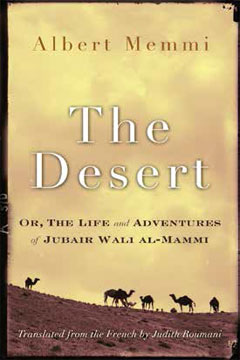Albert Memmi
The Desert
Or, The Life and Adventures of Jubair Wali Al-Mammi
Translated from the French by Judith Roumani
Syracuse University Press 2015 ISBN: 978-0-8156-1055-7
Reviewed by Ewa Tartakowsky *
(Translated by Ralph Tarica)
When Albert Memmi published
Le Désert, ou la vie et les
aventures de Jubaïr Ouali El-Mammi, he was already a widely
recognized writer and intellectual based on his literary works:
La Statue de sel, which
enjoyed the advantage of having a preface by Albert Camus (Corréa,
1953), Agar (Corréa, 1955) and
Le scorpion, ou la confession
imaginaire (Gallimard, 1969).
The same can be said of his essays which clearly place the writer
in the post-colonialist camp, such as
Portrait du colonisé précédé du
Portrait du colonisateur, prefaced by none other than Jean-Paul
Sartre (Buchet Chastel, 1957) or
L’homme dominé: Le noir, le colonisé, le prolétaire, le juif, la femme,
le domestique (Gallimard, 1968).
Le Désert constitutes for its author a new way of approaching the
themes dear to him: Judeo-Arab identities, Maghrebinity, and the past as
a constituent element of the present.
Structured as an oral narrative, inspired by North African and
Middle Eastern tradition, Le
Désert explores the historical imagination of the Maghreb (generally
defined as inclusive of Morocco, Algeria, Tunisia and Libya).
Whereas La statue de sel,
Agar and Le scorpion are
of an autobiographical nature, Le
Désert has as its narrator a fictive ancestor of the author,
Al-Mammi. One can find
references to him in Le Scorpion,
where Memmi indicates by pseudo-historical explanations that his name
does not have an Italian but a Berber origin: “The first certain mention
of our presence here […] can be found in the Arab historian El-Milli
who, in his Chroniques
arabo-berbères cites, among the companions of La Cahéna, the famous
Judeo-Berber queen, a certain El-Mammi.”1
The novel is to a large extent inspired by the
Chronique of Ibn-Khaldoun but,
according to the author, “the historical facts do not […] serve so much
as facts but as triggers, catalysts” (XVII).
Thus, as Judith Roumani, the translator of this new
English edition of the novel, points out in her richly informative
introduction, the narrator, like Ibn Khaldoun, is charged with a
diplomatic mission to the court of Pedro I of Castile; he further meets
Tamerlane in 1400, one year before the encounter between Tamerlane and
Ibn Khaldoun. The figure of
this famous Arab historian is particularly apt for the character of
Al-Mammi: he is at the same time actor and chronicler, he leads a life
that is both active and contemplative, and his Muslim culture allows for
recalling the shared origins of the two monotheisms – Islam and Judaism
– in the Maghreb.
This return to the past, for the most part purely
imaginary, is not, however, tinged with nostalgia; for Roumani, it is
“the incarnation of the philosophy of the cyclical return of history”
(XIX). She detects this
cyclical character in the structuring of the novel – from the exile of
the narrator to his return, then to a new exile --, an intellectual
journey for Al-Mammi that leads him from an uncertainty of desire to the
conquest of wisdom characterized by the absence of desire, and, finally,
in the rhythm of the novel, linked to the foundation and the destruction
of empires. In this respect
Memmi mentions that he wanted “to write a novel at the same time about
Berber lands subdued, conquered, reconquered” (XXI).
Memmi inscribes this deep-rooted attachment to
Berber culture in his desire to write about his “diverse identities”
(XXI), a theme that runs through all his work.
In La statue de sel,
the writer describes the difficulties of reconciling French, Jewish and
Arab-Berber identities; in Agar
as well as in his scholarly writings he pursues this problematic of
plural identity among North-African Jews.
His texts will constitute a sort of matrix for writers with a
Judeo-Maghrebin background in post-colonial France, inspired by the
problematic of multiple identities and the history of the Jews in North
Africa.
Having roots deeply embedded in history can also be
perceived in Le Désert through
a number of Middle Eastern references, aphorisms, proverbs, stories,
fantastic tales based in oral tradition called
khurafa and written following the model of
A Thousand and One Nights or the
maqâmat (sessions), short stories that depict a conversation between
the characters, a tradition supplied by tales from Muslim travelers.
This practice cannot help but call to mind the author’s childhood
memories: “This way of telling stories is something I absorbed with my
mother’s milk […] My mother told me hundreds of stories.
One source for these tales was my father’s workshop.
Whenever my father went off to do some errands, the worker would
tell me stories […] A tale within
a tale, I’ve heard that thousands of times” (XXIV).
But in terms of historiography, it is also a possible plea in
favor of rehabilitating oral story-telling.
Having deep roots in tradition does not, however,
prevent Memmi from having recourse to humor and irony.
As he points out: “I got a lot enjoyment out of writing it, and I
hope readers will have just as much pleasure in reading it” (XXXVI).
It is with this quotation by Albert Memmi that Judith Roumani
concludes her introduction to this work, translated in a thoroughly
magisterial manner.
Le Désert is undeniably a
literary reference work in the rich biography of this writer and
university professor who never ceased leading the cause for plurality
within the universal and for a universality that is always present
within plurality.
* Ewa Tartakowsky holds a Ph.D. in sociology. She is a researcher at the Centre Max Weber and teaches in the Department of Sociology at the Université de Paris Ouest Nanterre La Défense.

